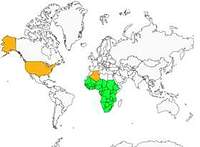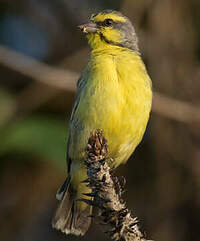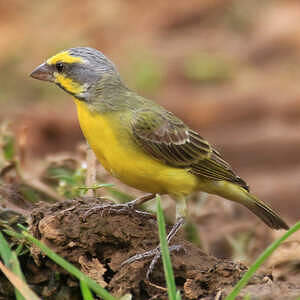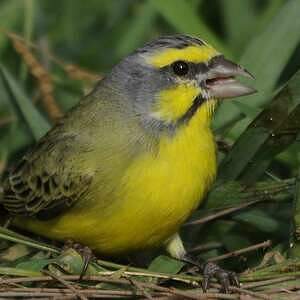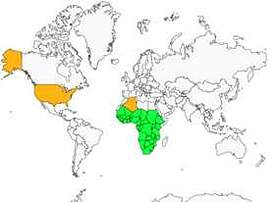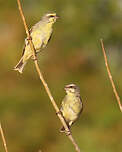Yellow-fronted Canary
Crithagra mozambica - Serin du Mozambique
Identification
The Yellow-fronted Canary is a small finch with a short tail and a prominent facial pattern with a large eyebrow. The male's forehead and big eyebrow are bright yellow. The lores and eye-stripe are dark brown becoming greyer towards the back of the ears. A fairly wide blackish moustachial stripe running down to the neck. The cheeks are bright yellow. The crown, nape, and sides of the neck are grey-olive to greyish-green finely streaked with blackish. The short, conical bill is dark brown to horn-brown on the upper mandible, the lower mandible is rosy or greyish-horn coloured. The iris is dark brown to black. The legs are brownish-pink to greyish-pink. The mantle, back and scapulars are grey-green finely streaked with dark-brown. The rump and upper tail-coverts are yellowish-brown tinged with green. The rectrices are brown to dark-brown finely edged yellow and their tips dull yellow. The primary coverts and flight feathers are blackish finely edged with pale green. The lower-throat to breast are bright yellow tinged with brownish on the sides of the breast. The belly and undertail coverts are bright yellow. From geographically adjacent species, it should be distinguished from three physically similar species. The Yellow-fronted Canary differs primarily from the White-bellied Canary by a shorter tail and a better defined facial pattern. Compared to the Sulphur-breasted Canary, it is smaller and the rump is brighter yellow. It is, however, slightly larger than the Saint Helena Canary with the nape greyer. The female is slightly greyer or duller, except the rump which remains bright yellow. The facial pattern is also duller or less well defined. The yellow edges of the wing coverts and flight feathers are less wide and the underparts duller.The juvenile looks similar to the female but its head is slightly darker gray. The face and chest are pale yellow washed out, the malar stripe is finer and slightly streaked or speckled on the chest side. These marks are more pronounced in the juvenile female than in the juvenile male. The upper parts and the rump are dull yellow-green. The tips of the median and upper wing coverts are however buckskin. Ten subspecies are currently recognized. These all differ mainly in the intensity of the green and yellow on the upper and lower parts but also from yellow-green with fine stripes in the north of the distribution area to gray-green with wide stripes in the south. Crithagra mozambica caniceps and punctiglula have a little less yellow on the forehead. The throat is paler yellow and the eye-strip darker. The cap is gray or pale gray to the nape. The mantle and scapulars are dull olive-green. The female of this subspecies has the chin and throat mottled blackish. Crithagra mozambica barbata does not have gray on the head but a dark olive-gray ocellus. The upper parts are yellower olive-green, the chest sides olive-green and the flanks tinted greenish. Crithagra mozambica gemeinsa is similar to the previous subspecies but with less yellow on the forehead and the upper parts are slightly darker. Crithagra mozambica samaliyae and tando are similar to C. m. barbata with the mantle and scapulars strongly streaked with dark. The parotic coverts are olive-green and the lower parts golden yellow. Crithagra mozambica grotei is very yellow on the forehead. The eye and malar stripes are olive-gray and the upper parts yellowish green with a brownish hue.Crithagra mozambica granti is quite similar to the nominate subspecies but the malar stripe is grayer and often joins the gray on the sides of the neck. The crown and upperparts are darker green and strongly streaked with black and the cheek coverts are dark olive-green. Crithagra mozambica vansoni is similar to the nominate subspecies but more dull and overall less streaked. Yellow-fronted Canary.
Subspecific information 10 subspecies
- Crithagra mozambica mozambica (Kenya to e Botswana, Zimbabwe, ne South Africa and sc Mozambique)
- Crithagra mozambica caniceps (s Mauritania, Senegal and Gambia to N Cameroon)
- Crithagra mozambica punctigula (c and s Cameroon)
- Crithagra mozambica grotei (e Sudan, w and sw Ethiopia)
- Crithagra mozambica gommaensis (Eritrea, nw and c Ethiopia)
- Crithagra mozambica barbata (s Chad and Central African Republic to sw Kenya and c Tanzania)
- Crithagra mozambica tando (Gabon to Angola)
- Crithagra mozambica samaliyae (se DRCongo, sw Tanzania and ne Zambia)
- Crithagra mozambica vansoni (se Angola, ne Namibia and sw Zambia)
- Crithagra mozambica granti (s Mozambique and e South Africa)
Foreign names
- Serin du Mozambique,
- Serín frentiamarillo,
- canário-de-moçambique,
- Mosambikgirlitz,
- mozambiki csicsörke,
- Mozambiquesijs,
- Canarino frontegialla,
- savannsiska,
- Savanneirisk,
- kanárik žltočelý,
- zvonohlík žlutočelý,
- Mozambiquesisken,
- viiksihemppo,
- Geeloogkanarie,
- gafarró frontgroc,
- afrokulczyk mozambijski,
- Мозамбикский канареечный вьюрок,
- キマユカナリア,
- 黄额丝雀,
- savannsiska,
- 黃額絲雀,
Voice song and call
The song of the Yellow-fronted Canary is often emitted in short bursts. It consists of animated series of soft and musical phrases: tseeu-tseeu - see-woo - way-tsee-way or way-tsrrr - toway-towee. Added to this are trills and gurgling notes reminiscent of the Canary's song. When the birds gather in flocks, the males' cries include simple or repeated chirrip, tsssp, tseeuu, tuwu-tsilip, swee-et and higher pitched zizzits, as well as a longer zeee-zereee-chereeo".
Habitat
The Yellow-fronted Canary is mostly a bird of plains and clearings where the trees do not form a closed environment. It lives in open forests, savannas with some thorny trees and near crops, in particular around millet fields and around agricultural buildings in cereal-growing areas. The banks of streams and rivers, wet areas such as swamps and mangroves with shrubs in coastal areas are also habitats occupied by them.
Behaviour character trait
The Yellow-fronted Canary is a resident in its distribution area with nomadic movements done outside of breeding season which consist of many individuals who wander in search of areas of food.
Therefore, it can be seen on the coast and east of Kenya from November to July while it will be absent from July to October. Elsewhere, there is little, if any, population movement. The Yellow-fronted Canary feeds in pairs or small groups. It is sometimes found in mixed species groups including Estrildids. It feeds on the ground, in the low vegetation as well as in trees. It also perches to perform some acrobatics in order to reach the seeds on the stems which it bends with its weight. It hunts insects on the ground or in flight but these are not instantly swallowed. It will go back to a branch in order to remove the elytra or wings of the flying insects. Outside of breeding season, the groups can reach hundreds of individuals. Often very vocal, the males of these groups sing together with other species.Dietfeeding habits
The Yellow-fronted Canary is mainly granivorous but its diet is varied in plants. It feeds on seeds, buds, flowers, fruits and nectar, leaves and some insects. The seeds are mainly from grasses and weed species. The insects added to the diet are grasshoppers, aphids, fly larvae and caterpillars as well as termites.
Reproduction nesting
The breeding season of the Yellow-fronted Canary is year-round in East Africa, from May to November in West Africa, from November to April in Zimbabwe, from September to March in Mozambique, and from September to April in South Africa. It is a monogamous species. Nesting is done in solitary pairs or semi-colonially, with a maximum of three nests in one tree. The breeding territory is very small, making the species highly territorial. During courtship, males pursue females in flight, often in small groups, through the branches of bushes or trees. These flight periods are interspersed with pauses, which correspond to rapid wing-beats and prolonged songs.
The nest is built by the female alone or sometimes with the male. However, the male does not collect the materials. The nest is a small, deep and compact cup made of grass, stems and vegetable fibers, leaves, dried seed spikes, bark, down, animal hair and spider webs. It is placed at a height between 1 and 8 metres above the ground (more generally below 4 metres) in the fork of a tree or shrub, often intermingled with thin twigs or leaves. It is often placed at the end of a branch, but may also be found at the top of a young tree, such as a pine, eucalyptus, or acacia. Other known locations are palm fronds or banana clusters. The female lays 2 to 4 eggs, a pure white to pale blue or creamy colour, sometimes spotted with brown-orange or dark brown. She is fed at the nest by the male while she alone incubates for a period of 13 to 14 days. The chicks are fed by their parents between 16 and 24 days. The family groups formed from the parents and the young remain united for a fairly long period, though the length of this period is unknown.The average lifespan of the Yellow-fronted Canary is 2 to 3 years on average, with a longevity of 8 years and 5 months. The success rate of clutches is 65% per year.Geographic range
The Yellow-fronted Canary is widely and commonly found in much of Sub-Saharan Africa with some apparently suitable non-occupied zones in central Democratic Republic of Congo and Angola. It is also absent in Namibia as well as in the centre and the west of Botswana and South Africa. Some evidence of recent expansions has been recorded in this part of west Africa due to forest degradation. Some introduced and escaped and then naturalized individuals are present in eastern United States and California, as well as in Taiwan, Hong Kong and Shanghai. Ten subspecies are now officially recognized.
Threats - protection
IUCN conservation status
concern
in the Wild
threatened
evaluated
The Yellow-fronted Canary is locally abundant and widespread, it is not globally threatened. However, the species easily domesticated and is often captured for the cage bird trade. It is of minor concern.
Sources of information
- IOC World Bird List (v14.2), Gill, F and D Donsker (Eds). 2024-04-18.
- Birds of East Africa: Kenya, Tanzania, Uganda, Rwanda, Burundi, Terry Stevenson, John Fanshawe
- Birds of the Horn of Africa, Nigel Redman
- Birds of the World, The Cornell Lab of Ornithology
- eBird, Cornell Lab of Ornithology et National Audubon Society
Other sources of interest
 Specification sheet created on
17/07/2023 by Nathalie Santa Maria
Specification sheet created on
17/07/2023 by Nathalie Santa MariaTranslation by AI Oiseaux.net
© 1996-2025 Oiseaux.net
- Accipitriformes
- Aegotheliformes
- Anseriformes
- Apodiformes
- Apterygiformes
- Bucerotiformes
- Caprimulgiformes
- Cariamiformes
- Casuariiformes
- Charadriiformes
- Ciconiiformes
- Coliiformes
- Columbiformes
- Coraciiformes
- Cuculiformes
- Eurypygiformes
- Falconiformes
- Galliformes
- Gaviiformes
- Gruiformes
- Leptosomiformes
- Mesitornithiformes
- Musophagiformes
- Nyctibiiformes
- Opisthocomiformes
- Otidiformes
- Passeriformes
- Pelecaniformes
- Phaethontiformes
- Phoenicopteriformes
- Piciformes
- Podargiformes
- Podicipediformes
- Procellariiformes
- Psittaciformes
- Pterocliformes
- Rheiformes
- Sphenisciformes
- Steatornithiformes
- Strigiformes
- Struthioniformes
- Suliformes
- Tinamiformes
- Trogoniformes


